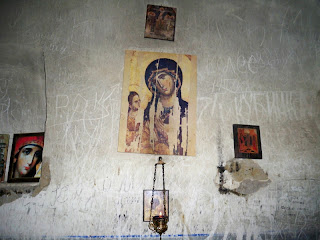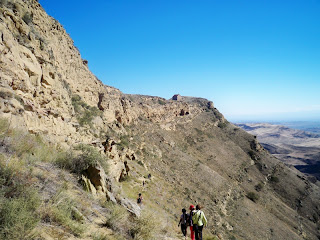გამარჯობა!
Hello! Hope everyone is
enjoying the end of October! I’m just
under two months away from my return back to the States! It’s quite exciting to
think about but there is still so much more I want to do and see before heading
back. I was actually thinking the other day about what I should write about next
on here since I haven’t visited any other cool places in the past two weeks. Since
I’m currently battling yet another stomachache, I've decided it might be the
time to talk about some Georgian food.
A lot of people back
home (notably my Dad) have been asking me about what kinds of food I’m eating
since I got here. Before I show you some
different dishes, you should know about a few key characteristics to any
typical Georgian dish: usually it includes some sort of carbohydrate, lots of
sunflower oil and probably vegetables grown our host family’s garden (or some
form of meat taken from a recently deceased animal also raised on the
property). So needless to say, Georgian
food isn’t all that nice on the digestive system and most of the dishes wouldn't be recommended for weight loss or for lowest-calorie count, but food is definitely
a huge part of the culture here, so I’m fully participating in it! Here's a small list of the food I see and eat most often here in Georgia:
.jpg) |
| khinkali |
Khachapuri (ხაჭფური): You’ve already heard a
bit about my
adventures with khachapuri in an earlier post, but it’s worth noting that
it’s different in all parts of Georgia. I’ve tried the three major kinds:
Imeretian, Adjarian, and Mingrelian. I might say that Adjarian might be my
favorite since the addition of the egg makes it taste just a little bit
different than the rest (in a good way). Of all the dishes I’ve seen made here,
I definitely plan on making this when I get back because it’s pretty simple and
quite frankly, who doesn’t love hot cheesy bread?
.jpg) |
| This is Mingrelian khachapuri with cheese on the inside and on top. |
.jpg) |
| Adjarian khachapuri. SO. GOOD. |
 |
| Imeretian khachapuri. This is the kind my host family makes with the cheese on the inside. |
Mtchadi: this is the small snack my host mother Tamila likes to make for
my host brother Luka and I. It’s basically just little patties of fried
cornmeal. You then eat it with cheese
while it’s hot and fresh out of the frying pan.
.jpg) |
| Mtchadi |
Lobiani (ლობიანი): Think khachapuri but with beans substituting for the cheese. Beans are ground into a mash and then
inserted into balls of dough which are then pressed into the flatten khachpuri
shape. It’s probably one of the better dishes
I’ve had here, even if it’s a little dry at times.
.jpg) |
| Lobiani |
Tsvadi: The Georgian barbecue.
This is meat speared on stakes that’s grilled over a small fire and is
served at every supra with onions. It’s
not bad if you manage to get a piece
that’s not entirely covered in fat, but it would be nice to add some BBQ sauce
to this to spice it up a little bit.
.jpg) |
| Need some Sweet Baby Ray's with this stuff!! |
Tonis Puri (თონის ფური): Puri is the Georgian word for “bread” and Tonis (or Tone) is the
Georgian word for the big cylindrical barrel fire that bakes the bread. Basically you take balls of bread dough,
flattened and elongated, and place them on the sides of this cylinder to
cook. What comes out is hot bread in a
flat, oval shape (most of the time). Many
people in the villages make this from scratch, and it is really cheap to
purchase (70 tetri or the equivalent of 40 cents). Georgia hasn't really discovered the whole sliced
bread phenomenon yet so everyone typically just tear a piece from the large
loaf that is served at literally every meal. If you are what you eat, then I’m
coming home as a loaf of bread from the amount I've eaten here.
.jpg) |
| This is how they make the bread. |
Cheese: Also served at almost every meal is cheese. Georgian cheese is pretty interesting in its
taste. I’m not quite sure how to
describe it other than its more salty than a lot of other cheeses I’ve had in
my life, but it’s something that I’ve gotten used to.
.jpg) |
| Bread! and you can see the chunks of cheese on the other plates. |
Tomato and Cucumber “salad”: A pretty standard salad here in Georgia has
been a mixture of tomatoes and cucumbers since I arrived here in August (tis
the season!). Since the daily vegetable
count here is low (or mostly fried potatoes), I load myself up on this every
time it’s offered at a meal. Tomatoes
here are actually really really good, and I might even say they are better than
some I’ve had back in the States, but it might help that they are home-grown
produce from the family garden!
Eggplant and Walnut dish: This dish is one of my favorites here in Georgia even though I’m
not a huge fan of eggplant to begin with.
You take eggplant and cut it into long strips and then fry it in
oil. After this, the eggplant cools
before adding this walnut mixture to it and folding it in half. Sometimes, pomegranate seeds are added to the
walnut mixture that makes for an interesting (yet delicious) texture
combination! I think it would be
interesting to try the eggplant baked instead of fried when I try to make this back home.
So really, this is
actually just a small list of all the different kinds of food I’ve had while in
Georgia. Some of the other ones I’ve only had maybe once or twice or I
just can’t remember the names. While this food sounds appealing, I have
to admit that I’m craving some American food like you wouldn't believe:
Honey Bunches of Oat cereal, brownies, and sushi (technically not American, but
I still want it!). Just one of the many things to look forward to when I'm back in time for Christmas!
Love and miss you all!
Kelsey
P.S. Props to Google for
having images of almost all the food! I haven't been one of those
"take pictures of every meal you have abroad" people while I'm here.
.jpg)
.jpg)
.jpg)
.jpg)
.jpg)
.jpg)
.jpg)
.jpg)
.jpg)
.jpg)
.jpg)
.jpg)
.jpg)
.jpg)
.jpg)
.jpg)
.jpg)
.jpg)
.jpg)
.jpg)
.jpg)
.jpg)
.jpg)
.jpg)
.jpg)
.jpg)
.jpg)